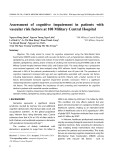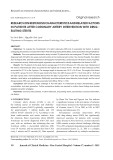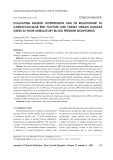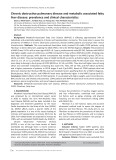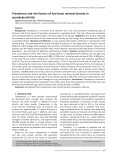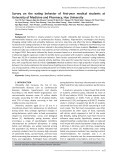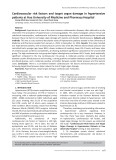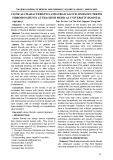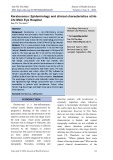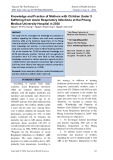
Can Tho Journal of Medicine and Pharmacy 10(7) (2024)
158
STUDY OF CLINICAL CHARACTERISTICS
AND SOME RISK FACTORS OF MIGRAINE HEADACHE
AT CAN THO CENTRAL GENERAL HOSPITAL IN 2022-2023
Ly Quoc Y, Dang Bich Loan, Duong Minh Thai, Pham To Tran, Le Van Minh*
Can Tho University of Medicine and Pharmacy
*Corresponding author:lvminh@ctump.edu.vn
Received:05/04/2024
Reviewed: 18/04/2024
Accepted:16/05/2024
ABSTRACT
Background: Migraine is a common disorder; however, it is still not perfectly diagnosed
and treated due to many difficulties in recognizing symptoms or accompanying risk factors.
Understanding migraine headaches through surveying standard samples can guide clinicians in the
appropriate way of diagnosis and treatment. Objectives: The study aimed to describe the clinical
characteristics of migraine and to investigate some risk factors related to migraine headaches
among patients examined at Can Tho Central General Hospital during 2022-2023. Materials and
methods: A cross-sectional descriptive study was conducted on 46 patients diagnosed with migraine
headaches at Can Tho Central General Hospital in 2022-2023. Results: We recorded that most of
the patients experienced headaches lasting from 24 to 72 hours, unilateral (left or right side) fixed
headaches, pulsatile headaches and severe intensity headaches with the proportions being 39.14%,
73.9%, 80.4%, and 63.1% respectively. The symptoms accompanying the headache included nausea
(67.4%), photophobia (52.2%), dizziness (34.8%), vomiting (32.6%), and absence of aura symptoms
(unilateral fixed headache, nausea or/and vomiting, photophobia or/and phonophobia) accounting
for 95.7%. Factors exacerbating headaches are stimulant use (21,7%), weather (19,6%), menstrual
conditions aggravating headaches in 16.7% of female patients, and physical activity (13.0%).
Factors alleviating headaches include using analgesics (60,9%), resting (39.1%), and avoiding
exposure to light and photophobia (4.3%). Influencing factors include female (65.2%), insomnia
(58.7%), anxiety disorder (52.2%), and family history of having a parent with migraine disease
(4.3%). Conclusion: The highest rates were observed among patients experiencing unilateral (left
or right side) fixed pain (73.9%) and pulsatile headache (80.4%). The most common accompanying
symptom is nausea (67.4%). The proportion of migraineurs without aura symptoms accounts for
95.7%. Stimulant use (21.7%) is the factors that exacerbate headaches the most. On the other hand,
avoiding exposure to light and noise reduces headaches in most cases (accounting for 60.9%).
Keywords: Migraine headaches, migraineurs, clinical characteristics, risk factors
I. INTRODUCTION
Migraine is defined as an episodic headache associated with certain characteristics
such as sensitivity to light, sound or movement. It can also be understood as a “recurrent
headache syndrome accompanied by other symptoms in a number of different mixed
neurological disorders" [1]. According to an analysis of The Global Burden of Disease
(GBD) study reported in The Lancet Neurology, nearly 1.04 billion people suffered from
migraine headaches in 2016 [2]. In Vietnam, migraine disease has a prevalence of 17.4%
[3]. Contributing to reducing this global burden, researchers have conducted studies on
migraine. For example, research by Burch et al (2018) showed that 1 in 6 Americans was
affected by migraines [4]. Additionally, research by Lam Tien Uyen (2020) noted that the
majority of patients experienced accompanying symptoms such as nausea, sensitivity to
light and noise, accounting for 77.6% and 81%, respectively [5]. To provide an overview





